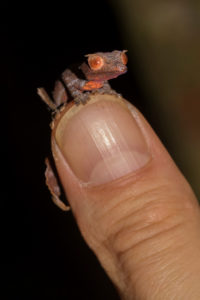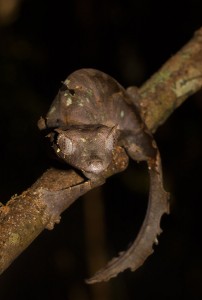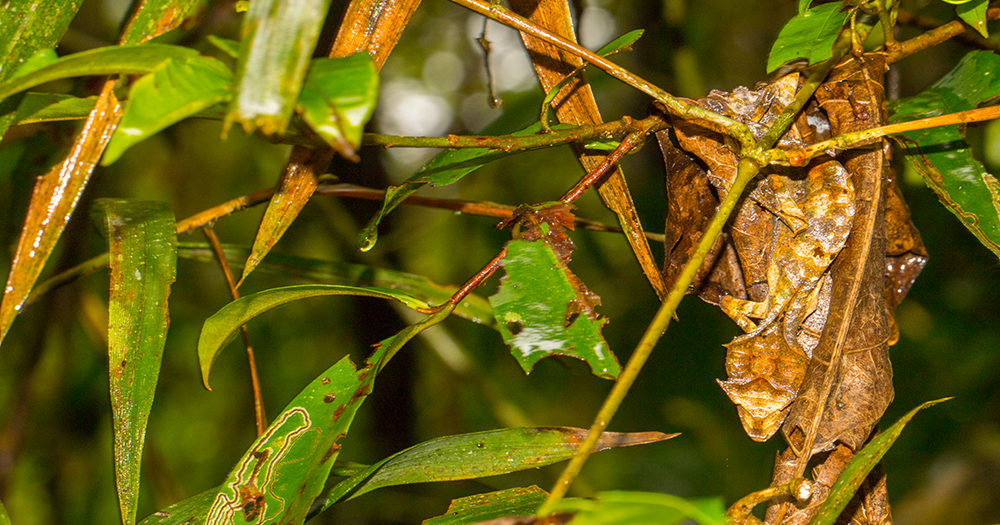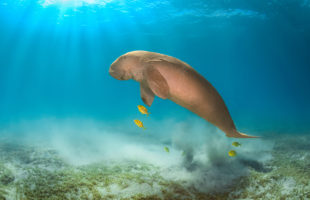A small but very pretty gecko lives well camouflaged in the rainforests of the central east and southeast in the highlands of Madagascar: the Satanic Leaf-Tailed Gecko (Uroplatus phantasticus). The little guy got his name from biologist George Boulenger as early as 1888. The Belgian first described the species and chose the name because of the bizarre appearance of the gecko. The Satanic Leaf-Tailed Gecko only occurs in Madagascar, so it is endemic to the island. The tail of this type is, as with the leaf-tailed geckos already name-giving, leaf-shaped and often provided with small cutouts, which imitate the optics of a dead leaf. The body colour is extremely variable and can produce astonishing patterns with partly bright orange belly and marbling on the back. Above each eye, the Satanic Leaf-Tailed Gecko carries a small, conspicuous projection that, like many other body appendages, helps to dissolve the body contour from the ground.

The distribution areas of the species range from Ankeniheny-Zahamena in the east of the island to the Andringitra Mountains in the south, Ivohibe is one of the most southern sites. In the national parks Ranomafana and Andasibe-Mantadia you can find the gecko especially in spring. However, a good eye or a resourceful guide is needed, because the Satanic Leaf-Tailed Gecko disguises itself motionlessly between dead leaves in the branches during the day. With a total length of only 9 cm, it is almost invisible hidden in dead leaves Only at night does the spooky little gecko become active – then he hunts cleverly for moths, crickets and other insects, usually not much higher than two or three meters above the ground.
Even predators don’t find it that easy, and when it does, the little gecko builds up threateningly and rips its shining pink mouth wide open. If he is attacked anyway, he can drop his tail and run away, while the thrown tail fidgets adventurously and distracts the attacker. The body part grows back completely within a few weeks and forms a so-called regenerate, which can be easily distinguished from the original tail by its slightly deviating color. In addition to this peculiarity, the ghostly leaf-tailed gecko is also equipped with other fascinating peculiarities: its feet are, as with all geckos, equipped with tiny lamellas. This enables it to adhere so firmly to substrates by means of adhesion that it could even run upside down along a smooth wall. The large eyes have eyelids, but they are not movable. As the eye cannot be moistened by blinking, the Satanic Leaf-Tailed Gecko uses its long tongue to clean the eye.

After a successful mating, the females of the Satanic Leaf-Tailed Gecko lay two small, round, white eggs each at the beginning of the rainy season, which are simply hidden in the foliage on the ground. On average, the females lay about six clutches per year. After two to three and a half months, tiny geckos hatch and find a richly laid insect table. They are exact likenesses of their parents, only substantially smaller: A Satanic Leaf-Tailed Gecko measures a maximum of 3 cm including tail when hatching. From the beginning they are on their own and can hunt in the wet rainforest like the big ones.
On the IUCN red list, the Satanic Leaf-Tailed Gecko is classified as “least concern”. However, there is a lack of data for a meaningful classification, because current population estimates of the species do not exist. Like so many habitats in Madagascar, the habitat of the Satanic Leaf-Tailed Gecko is severely threatened by slash-and-burn and deforestation. In addition, this species does not cope well with degraded vegetation and is dependent on dense primary rainforests. Once destroyed, the Satanic Leaf-Tailed Gecko can no longer colonize it. In 2007, the two German biologists Glaw and Vences considered whether due to the size differences between some populations (the animals from Fierenana are significantly larger) the Satanic Leaf-Tailed Gecko might be not only one, but possibly several species. This question has not yet been clarified. So there is still a lot of research to do with these exciting animals.
 MADAMAGAZINE Your Magazine about Madagascar
MADAMAGAZINE Your Magazine about Madagascar












